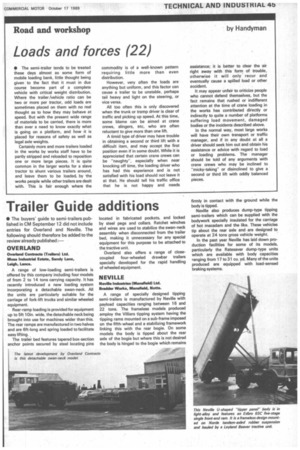Loads and forces (22)
Page 47

If you've noticed an error in this article please click here to report it so we can fix it.
• The semi-trailer tends to be treated these days almost as some form of mobile loading bank, little thought being given to the fact that it must in due course become part of a complete vehicle with critical weight distribution. Where the trailer /vehicle ratio can be two or more per tractor, odd loads are sometimes placed on them with no real thought as to how they may behave at speed. But with the present wide range of materials to be carried, there is more than ever a need to know exactly what is going on a platform, and how it is placed for reasons of safety as well as legal axle weights.
Certainly more and more trailers loaded in the works by works staff have to be partly stripped and reloaded to reposition one or more large pieces. It is quite common in the larger works for a slave tractor to shunt various trailers around, and leave them to be loaded, by the works people while other trailers are dealt with. This is fair enough where the commodity is of a well-known pattern requiring little more than even distribution.
However, very often the loads are anything but uniform, and this factor can cause a trailer to be unstable, perhaps tail heavy and light on the steering, or vice versa.
All too often this is only discovered when the trunk or tramp driver is clear of traffic and picking up speed. At this time, some blame can be aimed at crane crews, slingers, etc, who are often reluctant to give more than one lift.
A timid type of driver may have trouble in obtaining a second or third lift with a difficult item, and may accept the first position even if in some doubt. While it is appreciated that certain crane crews can be "naughty", especially when near knocking off time, the loading driver who has had this experience and is not satisfied with his load should not leave it at that. He should tell his traffic office that he is not happy and needs assistance; it is better to clear the air right away with this form of trouble, otherwise it will only recur and eventually cause a spilled load or other accident.
It may appear unfair to criticize people who cannot defend themselves, but the fact remains that rushed or indifferent attention at the time of crane loading in the works has contributed directly or indirectly to quite a number of platforms suffering load movement, damaged bodies or the incidents described above.
In the normal way, most large works will have their own transport or traffic manager, and if in any doubt at all a driver should seek him out and obtain his assistance or advice with regard to load or loading problems. The manager should be told of any arguments with crane crews who may be inclined to "micky-taking" or disinclined to give a second or third lift with oddly balanced pieces.




























































































































